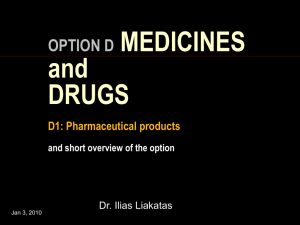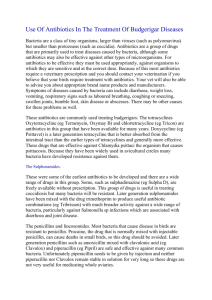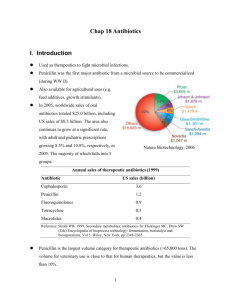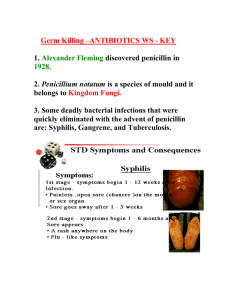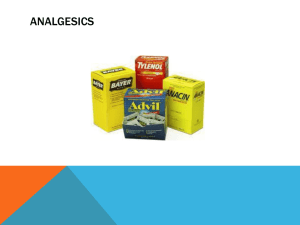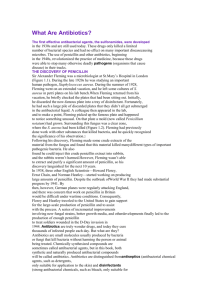Ppt on Medicines and Drugs - Atlanta International School Moodle
advertisement
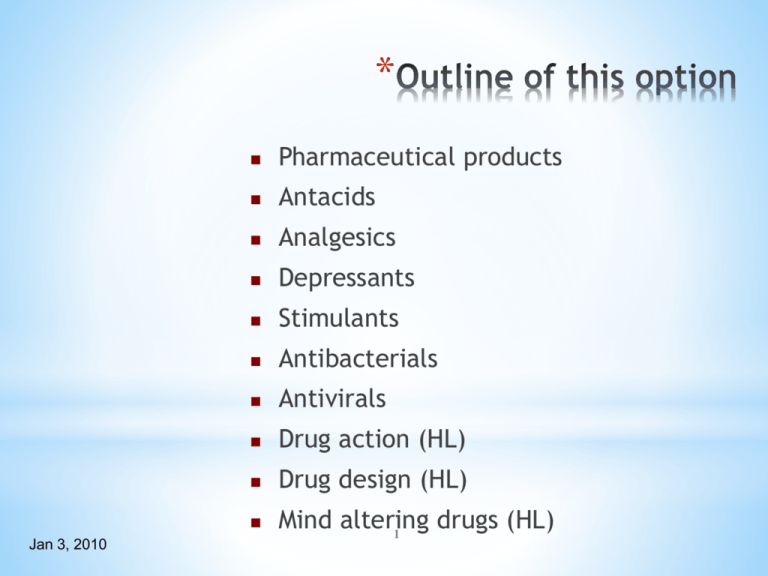
* Jan 3, 2010 Pharmaceutical products Antacids Analgesics Depressants Stimulants Antibacterials Antivirals Drug action (HL) Drug design (HL) Mind altering drugs (HL) 1 * * Jan 3, 2010 A substance that alters one or more of the following: Incoming sensory sensations Mood or emotions Physiological state Consciousness Activity level Co-ordination 2 * Infection fighters Affecting metabolism Hormones Vitamins Affecting central nervous system Jan 3, 2010 Antiseptics Antibiotics Antivirals Stimulants Depressants Analgesics 3 Anaesthetics * Jan 3, 2010 Inert substance but effective Used as control substance Power of suggestion Body’s natural healing 4 *Placebo effect: *A pharmacologically inert substance (often a sugar pill) produces a significant reaction because the patient expects, desires, or was told it would happen *Used as a control in clinical trials *Highlights the body’s natural healing powers *Research and Development: *Development of a new drug is a very costly, lengthy process controlled by the government: *In 1970, 3620 drugs were tested. 16 came on the market at an average cost of $20 million *Only 1 in 2000 drugs eventually make it to the market *Phase I: Initial clinical trials on volunteers after the drug has proven safe when given to animals *Phase II: Thorough clinical investigation to eliminate investigator bias *Phase III: Extended clinical evaluation •Early 1960’s given to pregnant women to treat morning sickness •Later found to cause major birth defects •One isomer controls morning sickness, the other leads to birth defects (optical isomers) * * * Tests on animals * Clinical trial (phase 1) * Clinical trial (phase 2) * Clinical trial (phase 3) * * * Jan 3, 2010 Dose, side effects Safety, dose range Response, investigator bias, statistics Extended evaluation > 16/3620 medicines into the market in 1970 > Thalidomide: for morning sickness but deformed babies 8 * Oral convenient, absorbed at small intestines * Rectal when not able from mouth or destroyed by acids Inhalation rapid, anaesthesia Parenteral / Injection Jan 3, 2010 Subcutaneous (dental, slow) Intramuscular (vaccinations, large V) Intravenous (fast, practical) 9 * * = the dose of a substance in mg per Kg of body mass, that kills 50% of sample * * * The smaller the LD50, the more toxic the substance Examples: aspirin * * Jan 3, 2010 10 rat: 200 rabbit: 1000 nicotine rat: 50 ethanol rat: 9000 * * = the dose of a substance in mg per Kg of body mass, that is effective to 50% of sample * * * * Jan 3, 2010 The smaller the ED50, the more effective the substance Examples: aspirin 11 55 * * = the ratio of LD50 over ED50 * * * Examples: The wider the window, the safer the substance aspirin therapeutic window = 200/55 * Jan 3, 2010 12 * Main effect (desired) Side effects (unwanted responses) * * * * Jan 3, 2010 Drug effects are relative!! Morphine: For pain relief, constipation is side effect For diarrhoea, pain relief is side effect 13 * * Increase of hazards (larger amounts) No tolerance to side effects Jan 3, 2010 Over time and with regular use, the user requires larger dose of the drug to achieve the effect originally obtained by smaller dose If drug not taken for long time > decrease of tolerance > overdose 14 And now a short presentation of the rest of the topics of this option... Jan 3, 2010 15 * Jan 3, 2010 Why is stomach acidic? How can we neutralize it? What are the most common antacids? What are the neutralizing reactions? With what can the antacids be combined? 16 * What are soft and strong analgesics? How do they prevent pain? Aspirin versus paracetamol? Jan 3, 2010 Morphine versus heroin/codeine? Advantages – disadvantages? 17 * Jan 3, 2010 What is their effect? How is effect dependant on dose? Tranquilizers Sedatives Hypnotics Anaesthetics Ethanol (effects, detection) Most common depressants? 18 * What is their effect? Adrenaline versus amphetamines Nicotine Jan 3, 2010 Short-term effects Long-term effects Caffeine Effects Comparison to nicotine 19 * Jan 3, 2010 The discovery of penicillin How penicillin works Modifications of penicillin Use and overprescription Broad versus narrow spectrum antibiotics 20 * Jan 3, 2010 Viruses versus bacteria How do antiviral drugs work? What is HIV and what AIDS? Why is it difficult to fight HIV? (AIDS prevention methods?) 21 * Jan 3, 2010 Geometrical isomers can have different pharmacological effects Examples: CISplatin – Thalidomide Optical isomers can have different pharmacological effects Examples: Thalidomide How structural features affect the pharmacological effect Examples: Penicillin, heroin 22 * Jan 3, 2010 Compound library Combinatorial and parallel chemistry Computer aided drug design Polarity modification Chirality modification 23 * Jan 3, 2010 LSD, Mescaline, Psilocybin, THC Effects similarities, differences Legalization of cannabis 24 D.3 Analgesics What is pain? An unpleasant sensory and emotional experience associated with actual or potential tissue damage. What are pain receptors and their functions. Pain receptors in our bodies are nerves that transmit pain. These are free nerve endings located in various body tissues that respond to thermal, mechanical and chemical stimuli. When stimulated, these pain receptors generate an impulse. The pain results of various impulses arriving at the spinal cord and the brain. When tissues become injured, they release chemicals called prostaglandins and leukotrienes that make the pain Definition of analgesics and categories Analgesics are drugs that relieve pain. These are: Mild analgesics: used for relief of mild pain. (aspirin, acetaminophen) Strong analgesics: used for relief of vary severe pain.(morphine, heroin, codeine) Local anesthetics: used as pain killers in localized areas.(lidocaine, procaine) Mild analgesics They work by blocking the enzymecontrolled synthesis of prostaglandins. The main effects prostaglandins are: The constriction of blood vessels, which helps increase the body temperature. Direct effect on the body’s heat regulating centre, hypothalamus, which produces fever. Natural painkillers They are produced naturally in the body. Endorphins and enkephalins are the natural opiates found in the part of the brain and the spinal cord that transmit pain impulses. They are able to bind to neuroreceptors in the brain and produce relief from pain. The temporary loss of pain immediately after an injury is associated with the production of these chemicals. Salicylic acid-Aspirin Salicylic acid was widely used as a fever reducer However, it is relatively strong acid so it was unpleasant to take orally and it damaged the membranes lining the mouth, esophagus and stomach. Sodium salicylate (its salt) was used but it was also highly irritating to the stomach. Its ester called Acetyl Salicylic Acid (ASA) named aspirin retains the beneficial properties of salicylic acid but is less irritating to the stomach. ASA is relatively tasteless so it can be taken orally. Uses of derivatives of salicylic acid mild analgesic for minor aches and pains. As an antipyretic. As an anti-inflammatory agent when there is swelling from injuries. As an anti-clotting agent in the prevention of abnormal blood clotting and as an anti clotting agent after heart As Disadvantages of Aspirin Aspirin can cause stomach upset and internal bleeding due to its acidic nature. There is a risk of developing severe gastrointestinal bleeding following use of alcohol. 0,5% are allergic to aspirin leading to skin rashes, respiratory difficulty and even shock Aspirin is one of the most frequent causes of accidental poisoning in infants. The taking of aspirin by children under twelve has been linked to Reye’s disease (a fatal liver and brain disorder with the symptoms of vomiting, lethargy, irritability and confusion.) Aspirin substitutes (Acetaminophen) Acetaminophen is the metabolic byproduct of phenacetin and is active ingredient of many over-thecounter drugs (OTC) It is like aspirin as it is an anti-pyretic. It is an analgesic to reduce mild pain. It does not upset the stomach or cause bleeding. It is not an effective anti inflammatory drug. It is a safe drug when it is used in the correct dose BUT can rarely cause side effect such as blood disorders and kidney damage. In great dose (>20 tablets) can cause serious liver damage, brain damage, coma and even death. Phenacetin Aspirin substitutes(Ibuprofen) Ibuprofen has many of the same effects as aspirin but seems to cause fewer stomach problems. It is an anti-inflammatory drug. It is effective in low doses and has a wide margin of safety. In great dose has similar side effects as ASA. Strong analgesics They temporarily bind to the opiate receptor sites in the brain preventing the transition of pain impulses -The opium alkaloids: Opiate: it is a natural or synthetic drug that exerts actions on the body similar to those induced by morphine. Narcotic: is a term generally used for drugs that have both a narcotic and analgesic morphine, heroin and codeine Morphine is the principal alkaloid and makes up about 10% by mass of raw opium. Codeine makes up about 0.5% by mass of raw opium. Heroin is usually synthesized from morphine and thus is a semi-synthetic drug and it is obtained by relatively simple structural modification of morphine or Opium plant Morphine Advantages and disadvantages of opiates. Pharmacological effects: Opiates exert major effects on: The central nervous system. The eye The gastrointestinal tract (the digestive system) The prime medical uses of opiates are: As strong analgesic in the relief of severe pain caused by injury and chronic disease. In the treatment of diarrhea by producing a constipating effect. To relieve coughing by suppressing the “cough centre” situated in the brain system. Advantages and disadvantages of opiates. Physiological effects of opiates: Opiate produce: Analgesia Drowsiness Mood changes Medical clouding Some individuals experience: Tolerance Tolerance appears due to the induction of drug metabolizing enzymes in the liver and also to the adaptation of neurons in the brain to the presence of the drug. The users that became tolerant to one opiate will also exhibit a tolerance to all other opiates. Dependence Physical dependence is the state in which people do not function properly without a drug. Symptoms: Restlessness Sweating Fever Chills Vomiting Increase rate of respiration Cramping Diarrhea Unbearable aches Dependence Depends on: The dose Frequency of drug administration The duration of the drug dependence The opiate used The opiates (in general) They are extremely potent and valuable drugs for the treatment of pain They have the capacity of inducing a state of euphoria and relief from physiological pain The opiates induce profound tolerance and physiological dependence They are important both medically and sociologically as the user is difficult to treat and must frequently resort to crime to support the habit and reach a source of Summary of the effects of opiates Short term effects Sedation and stupor Euphoria Reduced tension, worry and fear Reduced coughing reflex Occasional death from overdose Long term effects Loss of appetite Sterility Withdrawal illness, loss of job, crime Diversion of energy and money Risk of dangerous infections due to shared needles. D4: Depressants Jan 3, 2010 What are the depressants? Substances that calm and relax (depress) the central nervous system by interfering with nerve impulse transmission. Jan 3, 2010 They slow down brain activity They slow down heart activity They reduce breathing rate They dull emotional responses 51 What are the anti-depressants? Depressants are also called antidepressants because they relive depression. Jan 3, 2010 52 Categories of doses Low doses Moderate doses Little or no effect Sedation Soothing Reduction of anxiety High doses – Sleep Extremely high doses Jan 3, 2010 Comma Death 53 Tranquilizers Jan 3, 2010 Mild action Relieve anxiety and tension Ethanol & Valium 54 Sedatives Jan 3, 2010 Soothing of distress Not producing sleep at normal doses Barbiturates 55 Use and abuse of ethanol Doses Jan 3, 2010 30-50mg /100ml of blood Euphoria 100mg / 100ml of blood Slurred speech, staggering, aggressive behavior 200mg / 100ml of blood Difficult movement and vision 400mg / 100ml of blood Comma, death 56 Use and abuse of ethanol Social effects Sickness, death - Cost of treatment - Lost productivity Jan 3, 2010 Violent crimes Car accidents Alcoholism, family problems 57 Use and abuse of ethanol Physiological effects Jan 3, 2010 Short-term effects euphoria sociability relaxation decreased inhibitions loss of judgement impairment of perception/memory increased reaction time violent behavior dizziness loss of balance 58 nausea, vomitting Use and abuse of ethanol Physiological effects Long-term effects cirrhosis of liver liver cancer coronary heart disease high blood pressure strokes gastritis peptic ulcers anxiety/depression fetal abnormalities physical dependence/tolerance Jan 3, 2010 59 Use and abuse of ethanol Synergistic effects Jan 3, 2010 Alcohol + aspirin risk of stomach bleeding Alcohol + sedatives heavy sedation comma, death Alcohol + cocaine high blood pressure irregular heart beat 60 Detection of ethanol Breathalyzer Jan 3, 2010 Road-side test Ethanol in breath Oxidation of ethanol to ethanoic acid Use of acidified K2Cr2O7 Orange to green color Transfer of electrons > current > voltage measured 61 Jan 3, 2010 62 Detection of ethanol Chromatography (GLC) Jan 3, 2010 Ethanol in breath, blood and urine Inert gas through liquid or solid Compounds separated by b.p. Different retention times recorded Amount = area under peak Other drugs can be detected, too 63 Jan 3, 2010 64 Jan 3, 2010 65 Detection of ethanol Intoximeter (infra-red spectroscopy) Ethanol in breath Transmittance versus wavenumber =IR spectrum Characteristic peak of -OH @ 3340cm-1 Comparison of sample and reference Amount = size of peak Jan 3, 2010 66 Jan 3, 2010 67 Other depressants Diazepan (Valium) Jan 3, 2010 Sedative 68 Other depressants Nitrazepan (Mogadon) Jan 3, 2010 Sleeping pill 69 Other depressants Fluoxetin hydrochloride (Prozac) Jan 3, 2010 Anti-depressant Amine+HCl=hydrochloride: water soluble 70 Comparison Jan 3, 2010 71 D.5 STIMULANTS Stimulants are drugs that > stimulate the brain and the central nervous system > increase the state of mental alertness > decrease appetite A) Amphetamines B) Caffeine C) Nicotine Adrenaline (epinephrine) is a natural stimulant produced in the adrenal gland. > it is released when in stress or fear > it controls - heart/breathing rate - pupil dilation - sweating AMPHETAMINES • • Amphetamines are chemically related to adrenaline. They both derive from phenylethylamine. They are sympathomimetic drugs which mimic the effect of stimulation on the nervous system by increasing the levels of dopamine. • Amphetamines were initially used to treat narcolepsy and in WW II were used by soldiers to combat fatigue. • Later during the 50’s and 60’s they were used as slimming pills. • Regular use can lead to both tolerance & dependence. • Short-term effects: - increase in heart rate and breathing - insomnia - dilation of the pupils - decrease in appetite - possible fatigue and depression • Long-term effects: - weight loss - constipation - emotional instability - dependence • Phenylethylamine (love molecule) - “high” feeling of lovers - also found in chocolate Dopamine Transmits to neurons signals of - joy - happiness - excitement Amphetamine - stimulant - suppresses appetite - treats narcolepsy and attention deficit hyperactivity disorder (ADHD) Methamphetamine (“speed”) - potent stimulant - very addictive - severe withdrawal symptoms - “meth mouth” Ecstasy - potent stimulant - designer drug - can be fatal - neurotoxic CAFFEINE • It is the most widely used stimulant in the world. It is present in coffee, tea, chocolate and cola drinks and is also found in some pain killers or other medicines. • People that consuming 400 mg of caffeine a day may have dependence & physical side effects. • Like nicotine, morphine, codeine and cocaine, caffeine is also an alkaloid. • Alkaloids are nitrogen-containing compounds of plant origin containing heterocyclic rings and a tertiary amine group. • Theobromine has a similar structure to caffeine, which is also found in chocolate. (It does not contain bromine!) • caffeine theobromine Effects at low doses: - respiratory stimulant - weak diuretic - enhances concentration and alertness - reduces migraines (constriction of blood vessels) • Effects at high doses: - anxiety - irritability - sleeplessness • NICOTINE One third of the world’s population is addicted to smoking because tobacco contains nicotine • Nicotine produces psychological and/or physical dependence • • Nicotine builds up tolerance Stopping smoking can produce temporary symptoms like a craving for tobacco, nausea, weight gain, insomnia, irritability and depression • Short-term effects: - stimulates nervous system - increases heart rate and blood pressure - increases concentration - constricts blood vessels - stresses heart - reduces urine output • Long-term effects: - increases risk of heart disease coronary thrombosis - inhibits ability of blood to carry oxygen (CO) - excess acidity > peptic ulcers - mouth/lung cancer - adverse effects on pregnancy Both compounds are heterocyclic with one or more carbon atoms in the ring replaced by nitrogen atoms. They both contain a tertiary amine group caffeine nicotine D.6 Antibacterials Antibacterials/Antibiotics = Drugs that prevent the growth of, or kill, microorganisms that cause infectious diseases. These drugs are selective, they are ineffective against normal body cells. Microorganisms = single celled life forms capable of independent life if given a required amount of nutrients. Infectious diseases = Occur when the body’s natural defenses are ineffective due to 1) lack of natural immune system against infection. 2) too many microorganisms for the body’s immune system to overcome. 3) rapid growth of the microorganisms. Infectious Agents There are two types of infectious agents: • Bacteria • Viruses Antibiotics are ineffective against viruses since they incapable of combating normal body cells. Antibiotics aid white blood cells by 1. Preventing bacteria from multiplying 2. Preventing cell division (bacteriostatic drugs) 3. Directly killing Bacteria (bacteriocidal drugs) Examples of bacterial infections: tetanus, tuberculosis (TB), cholera, etc. Examples of Viral infections: influenza, common cold, hepatitis, etc. History of Penicillins 1890s: Found out that certain fungi killed bacteria. 1928: Alexander Fleming finds out that the mold penicillium notatum prevented the growth of the bacteria staphylococcus aureus. 1940: Florey and Chain used penicillin on mice. 1941: Penicillin used for the first time on a human being. 1943: Penicillin available clinically. 1945: Fleming, Florey and Chain receive Nobel prize. Alexander Fleming, a bacteriologist Florey and Chain renewed Fleming’s research Structure of Penicillin Penicillin G (first penicillin used): deactivated by 1) stomach acid injected into body. 2) Penicillinase, an enzyme created by bacteria Penicillin V: acid resistant penicillin created by modifying side chains. Active penicillin: Aminopenicillanic acid, 6 APA, (common in all penicillins) and a sidechain: • C6H5-CH2: benzyl penicillin or penicillin G • C6H5-CH2-CH2-:penicillin V • Cloxacillin, effective against pencillinase and acid. Penicillin G Spectrum of Antibiotics Broad spectrum antibiotics = one that is effective against a wide variety of bacteria. Examples: • Ampicillin • Tetracyclines such as Aureomycin and Terramycin. ‘Mycin’ is the suffix used for antibiotics obtained from soil fungi. Repeated use: 1) wipes out harmless bacteria 2) wipes out helpful bacteria such as those in the Oesophagus, stomach and large intestines. 3) destroyed bacteria may be replaced by harmful ones. Narrow spectrum Antibiotics = the antibiotics effective against only certain types of bacteria. Most penicillins (and sulfa drugs) are narrow spectrum antibiotics. Treatment of infection: Ideally bacterium should be identified before prescribing antibiotic. But this takes time so first a broad spectrum antibiotic is given and then a narrow spectrum one. Bacteriocidal Drugs Bacteria have cell walls mainly composed by polysaccharides that protects their cell structure and inside components. These cell walls are strong due to the chemical cross-links. How does it work?: 1. Penicillins interfere with cell wall construction of bacteria. 2. The cross links are destroyed, hence weakening the cell walls. 3. Bacteria is unable to hold its size and shape. 4. Water enters by osmosis, the cell expands and bursts 5. Bacteria is killed by this. Bacterial cell walls Disadvantages of Penicillin Use 1. Small percentage of the population (10%) experience allergic reactions and other side effects such as body rash. 2. If used repeatedly, it may wipe out harmless or helpful bacteria. In addition these bacteria that are wiped out may be replaced by harmful bacteria. 3. Genetic resistance of bacteria. If antibiotics are used extensively some bacteria survive and pass on their immunity to next generations. Such examples are Typhoid, Gonorrhoea and Malaria. A microorganism may become resistant as a result of mutation. A mutated bacteria may produce an enzyme that makes antibiotics ineffective. Result of these mutations: Need for constant renewal of antibiotics. Hence, antibiotics should only be used when no other treatment is effective. Use of Antibiotics Antibiotics are used to control animal diseases and to increase the rate of their growth (increase production). This is done by adding antibiotics to the animal feedstock which can contain animal pathogens which are dangerous to animals and humans. As before mentioned, if bacteria are extensively exposed to antibiotics they can develop an immune system that allows them to spread and reproduce quickly. Such are Salmonella and E.Colli that are not killed in animal feedstock Hence, is it wise to use routine addition of antibiotics to animal livestock? D.7 Antivirals What is HIV? • Human Immunodeficiency Virus. HIV attacks the immune system - the part of our body that protects us from infections and illnesses. It takes about 3 6 months for HIV to appear after infection. What is AIDS? • AIDS, the Acquired Immune Deficiency, is a disease caused by HIV. Once infected with HIV, it typically takes 10 years to develop AIDS (although in some, this time may be shorter). People with AIDS cannot fight common diseases, and therefore become very ill and die. A person can be infected with HIV and not have AIDS. HIV/AIDS Infection: How do you get it? • Unprotected sexual intercourse anal,vaginal, oral • Sharing drug needles and syringes • Sharing unsanitary piercing instruments • From mother to child • Blood contact HIV is NOT spread via… • Kissing • Biting • Blood sucking insects Who can get HIV? • ANYONE…Man, Woman, Gay, Straight, Christian, Jew, Black, White, Asian, Latino, Canadian, Young, Old …ANYONE. »That includes you! Can I tell if my partner is sick? • People who are infected can have the virus in their body for years before getting sick. During this time, they look and feel healthy. If they have sex with anyone, there is the chance that they will spread the virus to their sex partner. The College Facts • One in every 500 American college students is infected with HIV • The rate of HIV infection in the general American population is one in 250 • 4 factors that put college students at increasing risk: peer pressure, lack of maturity, increase in alcohol/drug use, and growing incidence of date rape
